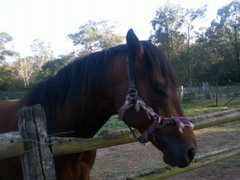
This absolutely beautiful young man is to be Her Ladyship's next breeding partner. He is straight Egyptian Arabian. His name is Chaswyck Caliph. She was to see him this year but was delayed by the outbreak of Equine Influenza.
This young stallion is heavily bred to Asfour (Malik x Hanan) who was imported from Germany for Simeon Stud. Simeon Stud has bred some of the most beautiful horses in the World, including a World Champion Stallion. They mostly breed Egyptian Arabians.
But Chaswyck Caliph was bred at Chaswick Stud, another Egyptian breeder, by their stallion, Simeon Sochain. He is a beautiful Chestnut stallion, loved and admired all over the world.
I feel if she knew she was going to visit him next year she might cheer up a bit. Alas, our communications are not that good.
The foal could actually be chestnut, since Her Ladyship's dam was chestnut. I am not too fussed over the colour, I would be just as happy with a grey or bay, but I really think the foal will be something to behold in conformation with this breeding. The mare has very good legs and shoulder, as has this young man. He has a very powerful hindquarter, which I am delighted with, and I am sincerely hoping it will be passed on to the foal.
A colt will be gelded at two months. That is the law around here. Meanwhile there are lots of things to do: keeping her in good condition, getting her next EI vaccine, having the vet check she is actually ovulating and so on.
She has been rubbing her neck where the microchip was placed. We have been trying to prevent her from doing this, but she does it whenever we can. I guess all the theory in the world wont prevent her from dislodging it or damaging it if she is really determined to do it. She doesn't know what it is and if it is annoying her, why not rub the damn thing?
So enjoy the picture.

